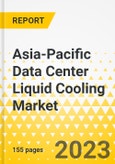Slow adoption and electricity outages in the Asia-Pacific region are major challenges to the data center liquid cooling market
10% Free customization
The Asia-Pacific data center liquid cooling market (excluding China), valued at $873.3 million in 2023, is expected to reach $9.70 billion by 2033, exhibiting a robust CAGR of 27.23% during the forecast period 2023-2033. The expansion of the APAC data center liquid cooling industry is significantly influenced by the emergence of cutting-edge technologies and the growing demand for energy-efficient cooling solutions. Several key drivers are contributing to this market's expansion, including the increasing need for cooling solutions that are both energy-efficient and space-saving. Moreover, the pursuit of lower operating costs and enhanced overclocking capabilities is propelling the adoption of liquid cooling solutions in data centers. This report comes with 10% free customization, enabling you to add data that meets your specific business needs.
The introduction of emerging technologies such as artificial intelligence and blockchain, along with the evolving landscape of high-density computing, presents significant opportunities for manufacturers in the APAC data center liquid cooling sector. Liquid cooling technologies offer a pathway to achieve higher processing density within the same physical space by effectively dissipating heat, allowing data centers to maximize their processing power without the need for extensive changes to their physical infrastructure.
Market Introduction
The growing need for energy-efficient cooling solutions in response to the region's expanding digital infrastructure is driving the robust expansion of the Asia-Pacific (APAC) data center liquid cooling market. With the advent of cloud computing, IoT, AI, and 5G technologies, data creation is increasing and conventional air conditioning techniques are finding it harder to manage the heat produced by high-density data centers. The use of liquid cooling, which is well-known for its exceptional efficiency, is growing in popularity since it may dramatically cut operating costs, enhance performance, and consume less energy.Key players in this market include China, India, Japan, and South Korea; these nations are propelled by the country's rapid digitalization, the emergence of hyperscale data centers, and government programs supporting green technology. Immersion cooling and direct-to-chip cooling are two examples of liquid cooling methods that provide enhanced thermal management, making them essential for maintaining server performance and sustainability.
As liquid cooling technologies help lower carbon footprints and energy consumption, environmental restrictions and sustainability goals in the APAC area are further driving the adoption of these solutions. The APAC data center liquid cooling market is expected to increase significantly as a result of ongoing expenditures in data center infrastructure and an increasing emphasis on energy efficiency. This market is essential to the region's aspirations to undergo a digital transformation.
Market Segmentation
Segmentation 1: by End Use Industry
- IT and Telecom
- Banking, Financial Services, and Insurance (BFSI)
- Government and Public Sector
- Healthcare
- Manufacturing
- Retail
- Others
Segmentation 2: by Data Center Type
- Hyperscale Data Center
- Enterprise Data Center
- Colocation Data Center
- Others
Segmentation 3: by Country
- Japan
- India
- Australia
- Singapore
- South Korea
- Rest-of-Asia-Pacific
How can this report add value to an organization?
Product/Innovation Strategy: The product segment helps the reader understand the different application and product segments of APAC data center liquid cooling and their potential in APAC Region. Moreover, the study gives the reader a detailed understanding of the different regulations, consortiums and associations, and government programs impacting the liquid cooling manufacturers for various purposes, including data centers.Growth/Marketing Strategy: The Asia-Pacific data center liquid cooling market has seen major development by key players operating in the market, such as business expansion, partnership, collaboration, and joint venture. The favored strategy for the companies has been partnership, collaboration, and joint venture activities to strengthen their position in the APAC data center liquid cooling market.
Competitive Strategy: Key players in the Asia-Pacific data center liquid cooling market analyzed and profiled in the study involve liquid cooling providers, including market segments covered by distinct product kinds, applications served, and regional presence, as well as the influence of important market tactics employed. Moreover, a detailed competitive benchmarking of the players operating in the APAC data center liquid cooling market has been done to help the reader understand how players stack against each other, presenting a clear market landscape. Additionally, comprehensive competitive strategies such as partnerships, agreements, and collaborations will aid the reader in understanding the untapped revenue pockets in the market.
This product will be delivered within 3-5 business days.
Table of Contents
Executive SummaryScope and Definition
1 Market: Industry Outlook
2 Regions
3 Markets-- Competitive Benchmarking & Company Profiles
4 Research Methodology
List of Figures
List of Tables
Companies Mentioned
The key companies in the Asia-Pacific Data Center Liquid Cooling Market include:- PEZY Computing Inc.
- Firmus Technologies Pty Ltd
- Shenzhen MicroBT Electronics Technology Co., Ltd
Table Information
| Report Attribute | Details |
|---|---|
| No. of Pages | 79 |
| Published | October 2024 |
| Forecast Period | 2023 - 2033 |
| Estimated Market Value ( USD | $ 873.3 Million |
| Forecasted Market Value ( USD | $ 9709 Million |
| Compound Annual Growth Rate | 27.2% |
| Regions Covered | Asia Pacific |
| No. of Companies Mentioned | 4 |









